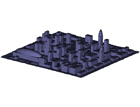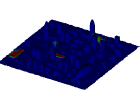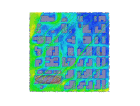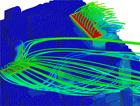 back back |
 up up |
||||||||
 |
|||||||||
| Written By: Kambiz Nazridoust | |||||||||
|
Introduction | |||||||||
|
Transportation devices, like automobiles, trucks, trains, ships, and airplanes are major sources of outdoor air pollution. Tight emission limitations, cleaner fuels, better engine designs, retiring old vehicles and so on are some of the policies to control and reduce these damages. Knowing the exact sources of pollution and the amount of damage from each are of high importance for environmental control. In recent years much progress has been made in such a qualification of the environmental damages and the costs (Delucchi and McCubbin, 1996, ExternE 1998). This work presents an overview of the methodology and an application of the case of automobiles in a typical city. Also in dispersion calculations, the increase in concentrations due to trapping of pollutants in the street canyons is examined. CO2 is assumed as the basic pollutant in this work. Using the commercial code, FLUENT™, the concentration of CO2 in the street canyons is calculated. The simulation is made for different conditions, for symmetric and asymmetric street canyons. Also a typical model for a city in three dimensions is made and solve with FLUENT™ CFD package. Street canyons can have a significant influence on the dispersion of the pollutants near the sources, as most automotive emissions take place at ground zero. There are two general ways that canyons affect the dispersion. First, by enhancing vertical mixing above the canyons and second, by trapping the pollutants into their physical boundaries and delaying pollutant transport to the freely moving air above the canyons. So the effect of canyons on the impact estimate is obvious; the higher local concentrations, the higher impacts and damage costs. The canyon effect is relevant only for primary pollutants. For secondary pollutants, it is less important as the canyon residence time is small compared to the time needed for chemical reactions. |
|||||||||
| Computational Modeling | |||||||||
FLUENT™ CFD package is used to solve the flow field in street canyons. Two and three dimensional analyses are made. In two dimensions, simple rectangles are used to treat the buildings and different arrangements of canyon location and emission sources are considered. Cases of symmetric and asymmetric buildings with emission sources on the road or on the roofs are studied. In three-dimensional analysis, a small city with asymmetric arrangement of the canyons is considered and the flow field is solved inside the domain. It is assumed that air is moving from left to right with a speed of 3 m/s, with a turbulent profile using 1/7th power law. To simulate the emission sources, small inlets of diameter 1m, are used inside each canyon, or on the roofs of buildings. CO2 is entered from these inlets as a secondary flow, and using the multi-zone model in FLUENT™, the flow field is calculated. The inlet velocity for emission sources is held at 0.3 m/s. Some animations of the pathlines and the particle trajectories are shown here. |
 |
||||||||
 |
|||||||||
 |
|||||||||
| Particle Transport | |||||||||
|
Carbon particles of diameter 0.01 to 10 microns are injected into the street canyons; transport and deposition of the particles are studied. Particle deposition rate and its pattern changes with the wind velocity and the setup of the building. Two animation files for symmetric and asymmetric street canyons are shown here. |
  |
||||||||
| Useful Links | |||||||||
|
Emissions in Street Canyons |
|||||||||
|
Copyright © Kambiz Nazridoust, 2005. |
 back back |
 up up |
|||||||


